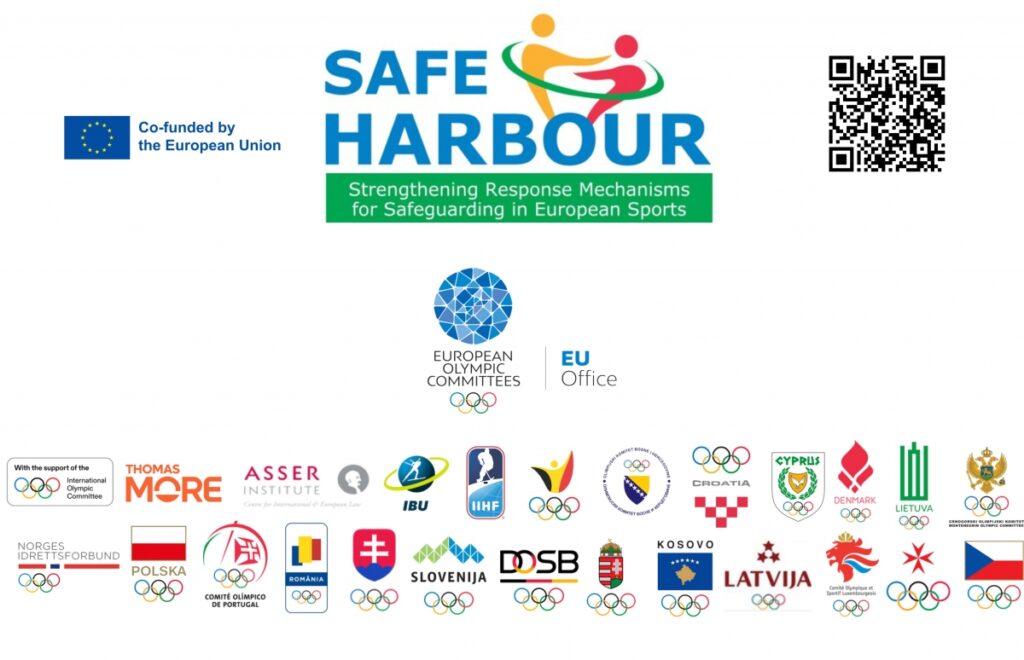The SAFE HARBOR project, an Erasmus+ initiative aimed at strengthening protection mechanisms in European sport, officially started with a meeting held on January 28 and 29, 2025 in Brussels.
This important event brought together partners from all over Europe, including representatives of the International Olympic Committee (IOC), National Olympic Committees (NOCs), international sports federations, academic institutions and the EU Office of the European Olympic Committees (EOC).
The meeting was attended by Maja Peković and Mladen Vlahović in front of the Montenegrin Olympic Committee.
The formal part of the program was opened by Volker Helmund and Carlota Giusini from the EOK EU office. This was followed by a session led by Helena Kamencikova from the European Commission, which included useful recommendations and practical advice for the successful implementation of the project.
During the afternoon, several presentations were held that highlighted the importance of protection in sports. Prof. Emerita Kari Fasting of Equal Rights in Sport presented the history of safeguarding in sport, providing valuable context for the project’s aims. After that, the IOC and EOC visions on protection were presented, presented by Kirsty Barrows (IOC Protection Unit), Annamarie Phelps (IOC Gender Equality Commission) and Maja Smrdu (IOC Ethics Commission). Additional insights were provided by Karolien Adriaens from Thomas More University, who spoke about the scale and frequency of protection problems in European sport, and Daniela Herdt from the Asser Institute, who introduced the meeting participants to existing systems and regulations.
The second day of the meeting began with a review of the previous day’s discussions before moving on to specific activities within work package 2. The focus was on mapping the current state of protection, with discussions on the GAP report, mapping actors and sessions for mutual exchange of experiences in the classification of protection problems. Afterwards, the roundtable provided a platform for NOCs and international federations to share their experiences, highlighting good practices and challenges they face in implementing safeguards.
Later in the day, the practical aspects of project implementation were presented, providing concrete steps and a clear plan for the consortium. The meeting was concluded with a session summarizing the main conclusions and defining the next steps for the SAFE HARBOR project.
This meeting was an opportunity to define roles, share knowledge and strengthen the sense of cooperation between all 27 partners involved in the project. This marked the beginning of a united effort to address the challenges in the field of protection in European sport. With a shared commitment to creating a safer and more inclusive environment, the SAFE HARBOR project is now ideally placed to drive significant change and make safeguarding a fundamental part of sport governance across Europe.
ABOUT THE PROJECT
The Erasmus+ project, “Strengthening protection mechanisms in European sport” (SAFE HARBOR), represents a significant step towards creating a safer and more inclusive environment in European sport. The project will last until June 2027 and brings together a diverse consortium of 27 partners, including the International Olympic Committee (IOC), two international federations, 20 National Olympic Committees (NOCs), as well as renowned academic institutions such as Thomas More University and Asser Institute.
Cooperation to strengthen protection in sports
Under the coordination of the EU office of the European Olympic Committees (EOC), the project aims to improve protection measures across Europe, encouraging cooperation and knowledge sharing among all participants. The consortium will work towards ambitious goals that include:
- Mapping existing security practices and assessing gaps.
- The development of a European Conservation Framework, which will provide comprehensive guidance for conservation activities on the continent.
- Creation and implementation of national strategies adapted to the specific needs of partner countries.
- Organizing specialized training programs to equip participants with the knowledge and tools needed to address challenges in the field of protection.
Sustainability
One of the key objectives of the SAFE HARBOR project is the establishment of the European Network for Protection in Sport (ENSS). This innovative online platform will act as a hub for collaboration, enabling the exchange of best practices and ensuring the long-term sustainability of safeguarding initiatives in European sport.
In order to further expand the reach and impact of the project, a series of national events will be organized. These events aim to raise awareness and share knowledge with a wider range of stakeholders, including local sports organisations, policy makers and community leaders.
Empowerment of protection officers and NOCs
The SAFE HARBOR project will empower partner NOCs and sports federations with practical tools and strategies for effective implementation of safeguards. The project also aims to establish a strong support network for protection officers, ensuring they have the resources and confidence to carry out their key roles. Additionally, the project will lay the foundation for the future IOC Regional Center for Safety, setting the standard for excellence in safety in sport governance.
A more secure future for European sport
With its comprehensive and collaborative approach, the SAFE HARBOR project aims to make safeguarding a fundamental part of European sport. By addressing existing challenges, filling gaps in implementation and creating sustainable mechanisms, the project will contribute to a safer and more inclusive environment for athletes, coaches and all actors in sports.
The SAFE HARBOR project is not just policy development – it is a driving force for cultural change in European sport, ensuring that safeguarding becomes an integral part of it.
